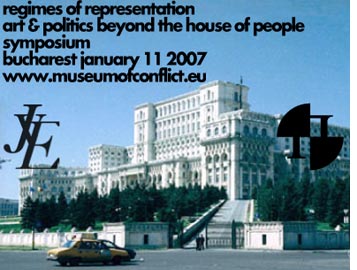Looking east, towards the new 2007 EU members, might be quite interesting in many regards. One of these is very directly addressed by an upcoming conference – ‘Regimes of Representation: Art & Politics Beyond the House of People’ – at the Romania’s national museum of contemporay art: MNAC in Bucharest, which formerly had been named the House of People.
| The Palatul Parlamentului and its current co-function as a museum, will be the point of departure for a discussion of the relation between post-communist politics, imagination and representation. mnac is one of various attempts to use contemporary art to transform a former ‘totalitarian’ symbol into one for democracy, but it is unique in simultaneously being the seat of government. |  |
Consequently the abstract for Chantal Mouffe‘s keynote speech focuses specifically on issues of space, politics and critical artistic practice in general, – as well as under these distinct circumstances connecting to her earlier analysis and points for developing her recent argument:
In my presentation I will discuss the different ways to envisage the public space and scrutinize the implications of this discussion for artistic practices. My argument will be that public art is not art located in a place that is public – as opposed to private space. Public art is art that institutes a public space, in the sense of a common action by people. I will for instance address the question of what kind of public progressive art institutions should try to institute: a public space that aims at establishing consensus or a public space of agonistic confrontation?
… I will first show that the task of democratic politics is not to aggregate interests or to attempt at reaching a rational consensus, but to transform antagonism into agonism. Then I will draw the consequences of this approach to understand the relation between art and politics and to grasp the nature of critical artistic practices. …
… I will first show that the task of democratic politics is not to aggregate interests or to attempt at reaching a rational consensus, but to transform antagonism into agonism. Then I will draw the consequences of this approach to understand the relation between art and politics and to grasp the nature of critical artistic practices. …
